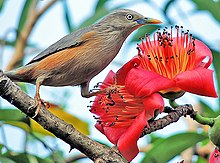Grey-headed myna
| Chestnut-tailed starling | |
|---|---|
 |
|
| Sturnia m. malabarica on Red silk cotton flower in Mangaon, Maharashtra, India | |
| Scientific classification | |
| Kingdom: | Animalia |
| Phylum: | Chordata |
| Class: | Aves |
| Order: | Passeriformes |
| Suborder: | Passeri |
| Infraorder: | Muscicapoidea |
| Family: | Sturnidae |
| Genus: | Sturnia |
| Species: | S. malabarica |
| Binomial name | |
|
Sturnia malabarica (Gmelin, 1789) |
|
 |
|
| approximate range | |
| Synonyms | |
|
Temenuchus malabaricus |
|
Temenuchus malabaricus
The chestnut-tailed starling or grey-headed myna (Sturnia malabarica) is a member of the starling family of perching birds. It is a resident or partially migratory species found in wooded habitats in India and Southeast Asia. The species name is after the distribution of a former subspecies in the Malabar region. This resident population has a white head and is often treated as a full species, the Malabar starling (Sturnia blythii).
The lack of monophyly in the earlier starling genera has led to this species being placed variously under genus Sturnia, Sturnus and Temenuchus in the past (Zuccon et al., 2006) and studies have suggested the reuse of an old name Temenuchus for members of this clade. Later studies have suggested placement in the genus Sturnia.
There are two subspecies of the chestnut-tailed starling:
Both the nominate subspecies and nemoricola are known to perform some poorly understood movements (e.g. S. m. malabarica has been recorded from Pakistan and in central and southern India).
The taxon blythii is now usually (e.g. Rasmussen & Anderton, 2005) considered a valid species, the Malabar white-headed starling or white-headed myna (Sturnia blythii), instead of a subspecies of Sturnia malabarica. As S. m. malabarica only visits the range of blythii during the non-breeding period (winter), the two are not known to interbreed. However a molecular study found the genetic divergence between S. m. blythii not significantly greater (between 0.2% and 0.8%) than between the sisters S. m. malabarica of northern India and S. m. nemoricola of Burma and Vietnam.
The adults have a total length of approximately 20 cm (7.9 in). They have grey upperparts and blackish remiges, but the colour of the remaining plumage depends on the subspecies. In the nominate subspecies and blythii, the underparts (incl. undertail) are rufous, but in nemoricola the underparts are whitish tinged rufous, especially on the flanks and crissum (the undertail coverts surrounding the cloaca). The nominate and nemoricola have a light grey head with whitish streaking (especially on crown and collar region). Both subspecies have white irides and a yellow bill with a pale blue base. The sexes are similar, but juveniles have whitish underparts and just chestnut tips to the tail feathers.
...
Wikipedia

